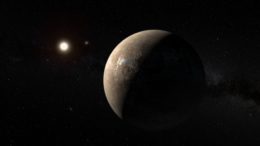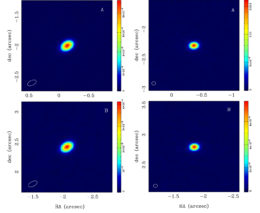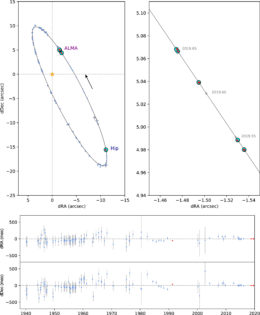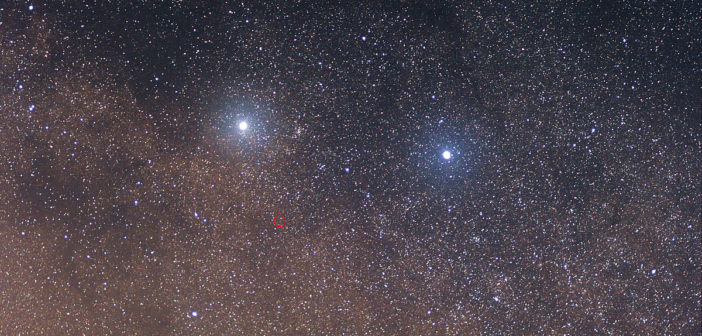Don’t plan to knock on a door at Alpha Centauri asking to borrow a cup of sugar just yet — but with a new look at this star system using a powerful telescope, we now know a bit more about our neighbors.
Secrets Among Nearby Stars

This artist’s interpretation shows the planet Proxima Centauri b around its host star. You can see the binary α Cen AB in between the planet and star, as two faint white dots in the background. [ESO]
Recent news has hyped the discovery of two exoplanets around the red dwarf Proxima Centauri — but what other surprises might the larger stellar system harbor? Given that α Cen A and B are both very similar to the Sun, it would be particularly valuable if we could find Earth-like, potentially habitable worlds around these near neighbors.
Choosing a Method
But how to detect them? Searching for transits works only for very specific orbit orientations. Direct imaging might be an option, since α Cen is so close. But even these nearby stars are challenging: α Cen A’s habitable zone lies at about 1.2 au, or just 0.9” in angular separation, from our point of view. It’s hard to confidently detect a small, dim object at that separation!

Calibrated images of α Cen A and B taken with ALMA in October 2018 (left two panels) and in August 2019 (right two panels). [Adapted from Akeson et al. 2021]
Hints of Influence
Astrometry relies on the idea that the slight gravitational tug of an orbiting planet causes a star to “wobble” in place. If this effect is large enough, we can detect it via meticulous imaging that very precisely tracks the location and motion of the star on the sky over time.
Taking advantage of the high-resolution observations provided by ALMA’s long baseline, Akeson and collaborators captured measurements of α Cen A and B during 2018 and 2019. Their results provide the first high-accuracy absolute measurements of the stars’ positions on the sky since 1991, as well as the highest-accuracy differential astrometry yet, comparing their relative separation and searching for the tiny influence of planets around the two stars.

Top left: astrometric measurements (red: Hipparcos and ALMA data, blue: archival data) and best-fit orbit of α Cen B relative to α Cen A. Top right: enlargement of the 2019 ALMA measurements (the total orbit takes ~80 years). Bottom: residuals of the fit as a function of time. [Akeson et al. 2021]
A Promising Future
Akeson and collaborators show that ALMA can produce remarkably precise astrometric measurements for the α Cen system, demonstrating the exciting potential of using ALMA for this technique. Though the observations don’t reveal signs of a planet yet, continued monitoring should allow us to ultimately be able to detect planets of a few tens of Earth masses in stable orbits between 1 and 3 au around α Cen A.
But these results go beyond our search for planets — they also refine our measurements of α Cen’s motions. This allows us to make more accurate estimates of the physical properties of α Cen A and B, filling in our understanding of our nearest neighbors.
Citation
“Precision Millimeter Astrometry of the α Centauri AB System,” Rachel Akeson et al 2021 AJ 162 14. doi:10.3847/1538-3881/abfaff

